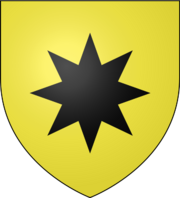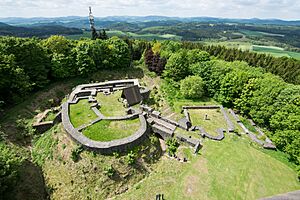Josias I, Count of Waldeck-Eisenberg facts for kids
Quick facts for kids
Josias I, Count of Waldeck-Eisenberg
|
|
|---|---|
| Count of Waldeck-Eisenberg | |
| Coat of arms |  |
| Reign | 1578–1588 |
| Predecessor | Wolrad II |
| Successor | |
| Full name |
Josias I Count of Waldeck-Eisenberg
|
| Native name | Josias I. Graf von Waldeck-Eisenberg |
| Born | Josias Graf von Waldeck-Eisenberg 18 March 1554 Eisenberg Castle |
| Died | 6 August 1588 (aged 34) Eisenberg Castle |
| Buried | 9 August 1588 Saint Nicholas Church, Korbach |
| Noble family | House of Waldeck |
| Spouse(s) | Mary of Barby and Mühlingen |
| Issue Detail |
|
| Father | Wolrad II of Waldeck-Eisenberg |
| Mother | Anastasia Günthera of Schwarzburg-Blankenburg |
Count Josias I of Waldeck-Eisenberg (German: Josias I. Graf von Waldeck-Eisenberg; 18 March 1554 – 6 August 1588) was a German nobleman who was Count of Waldeck-Eisenberg from 1578 until his death.
In the ten years of his short reign, Josias began the long overdue reform of the state administration, including the regulation of the churches, which aimed to strengthen the internal affairs of the state and thus achieve a clear independence of the county and a separation from Hesse. To solve the problems of the time, however, a longer reign of Josias would have been necessary, as well as a like-minded attitude of the other counts of Waldeck. Among them he took the leading position.
Biography
Josias was born at Eisenberg Castle on 18 March 1554 as the sixth child of Count Wolrad II 'the Scholar' of Waldeck-Eisenberg and Countess Anastasia Günthera of Schwarzburg-Blankenburg. Josias' two older brothers, Francis and Henry William, died at a young age. Josias was well educated and disciplined. From his youth he rejected excessive drinking and is said to have forbidden it to others. He entered the court in Kassel in 1570 and initially served Landgrave William IV of Hesse-Kassel. There he met Elector Augustus of Saxony, who employed him only a few months later. Josias took part in military campaigns in East Frisia. He did not return to Waldeck until February 1577. After the death of his father in 1578, Josias took over the government of the part of the county that was allocated to him. He moved the chancellery from Eilhausen to Korbach. Furthermore, he was still in the service of the Elector of Saxony and travelled to Dresden several times.
Already at the beginning of his reign, he succeeded in creating an important accent, whose unifying direction was, however, tempered by confessional differences. For the foundation of a modern state school in the former Franciscan monastery of Korbach, a Gymnasium Illustre according to the Strasbourg model, he not only got the consent of the other counts of Waldeck, the cadet branches Waldeck-Landau and Waldeck-Wildungen, but also of the estates of the realm and the cities with which he was otherwise in constant conflict. To finance the state school the properties of Berich Abbey, which had previously been administered by the count's family, were sold. The 15-year old Count Wolrad III himself attended the school which was opened in 1579. Because of the Protestant orientation, however, there were differences of opinion, as a result of which some of the renowned professors left the school in 1586 and moved to the Calvinist-oriented Academia Nassauensis in Herborn. Josias, on the other hand, oriented himself towards orthodox Lutheranism.
A contribution to the internal consolidation of the county and its sovereignty was the land ordinance of 1581, which, however, was only a police ordinance and not yet comprehensive legislation, which was only worked on in the 17th century. In order to strengthen his desire for independence, Josias had appointed qualified civil servants who no longer acted in the interests of Hesse but in the interests of the county.
Josias could not finish his work. He died suddenly and unexpectedly on 6 August 1588 at Eisenberg Castle, where guests from the baptism of his fourth child, Wolrad IV, were still staying. Josias was buried in the Saint Nicholas Church in Korbach on 9 August 1588. He was succeeded by his underage sons Christian and Wolrad IV, who were under the custody and regency of their mother and Count Francis III of Waldeck-Landau.
Marriage and issue
Josias married in 1582 to Countess Mary of Barby and Mühlingen (Magdeburg, 8 April 1563 – Waldeck Castle, 19/29 December 1619), daughter of Count Albrecht X of Barby and Mühlingen and Princess Mary of Anhalt-Zerbst. Josias' widow remarried on 19 November 1592 to Count George III of Erbach. She was buried next to Josias in the Saint Nicholas Church in Korbach on 5 January 1620.
From the marriage of Josias and Mary, the following children were born:
- Mary Anastasia (31 March 1584 – 5 March 1585).
- Count Christian (Eisenberg Castle, 24/25 December 1585 – Waldeck Castle, 31 December 1637), succeeded his father as Count of Waldeck-Eisenberg in 1588. Married in Wildungen in November 1604 to Countess Elisabeth of Nassau-Siegen (Dillenburg Castle, 8 November 1584 – Landau, 26 July 1661).
- Juliane (11 April 1587 – Erbach Palace, 28 February 1622), married in Erbach on 2 March 1606 to Count Louis I of Erbach (Erbach, 3 September 1579 – Erbach, 12 April 1643).
- Count Wolrad IV (Eisenberg Castle, 7 July 1588 – Arolsen, 6 October 1640), succeeded his father as Count of Waldeck-Eisenberg in 1588. Married in Durlach on 8 September 1607 to Margravine Anne of Baden-Hochberg (Hochberg, 13 November 1587 – 11 March 1649).
Sources
|
Josias I, Count of Waldeck-Eisenberg
House of Waldeck
Born: 18 March 1554 Died: 6 August 1588 |
||
| Preceded by Wolrad II |
Count of Waldeck-Eisenberg 15 April 1578 – 6 August 1588 |
Succeeded by Christian Wolrad IV |


